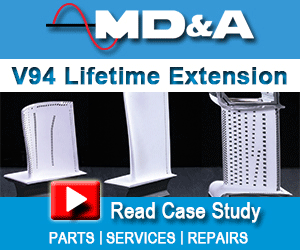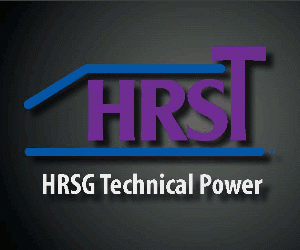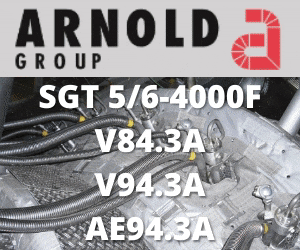The gas turbine/generator, steam turbine/generator, and HRSG get the lion’s share of attention at most user-group meetings, but one hallmark of the Combined Cycle Users Group is a focus on the connecting fluid handling equipment—pumps, valves, piping, ducting, and filters—covered in the presentations summarized below.
New challenges for filters. Headlines on the weather of course impact plant operations. Smoke and ash are plaguing facilities in the Northwest, severe weather challenges combined-cycle plants everywhere. A highly experienced plant manager, and member of the CCUG’s steering committee, led a roundtable discussion on how all this impacts filters.
Wildfire smoke particles are “really, really small” (comparable to bacterium and coronavirus particles and two orders of magnitude smaller than a grain of salt) and can pass through pre-filters and “quickly overwhelm” the filter media protecting the gas turbine. Plus, peaking units with tempering air run the risk of putting smoke particles directly into the SCR and fouling catalyst.
Planned maintenance for air inlet filters is a no-brainer, but there are materials shortages and delivery issues these days. The speaker reminded the audience that filters must be stored properly, with attention to maximum temperature for seals; auxiliary equipment like puffers should be included in PM programs.
Consider as well upgrading your pre-filters to a Minimum Efficiency Reporting Value (MERV) of 11 – 12 to trap some smoke particles and protect the final filter. One attendee recommended adding a transmitter to the DCS to monitor filter performance.
In severe cold, driving snow impacts filters, and causes ice buildup and freezing, regardless of protective hood size and configuration. Freezing of fog particles or cooling-water drift can impair filter performance in short order. It’s important to think through blockage scenarios before they occur and plan for heating panels or changes to the dispatch plan and reduced-load operation.
Boiler-feed-pump reliability. Segmental ring designs are lower first cost than barrel pumps but are less robust, said Robby Byron, Hydro Inc. They exhibit significantly less mass and therefore lower stiffness and damping, and are more susceptible to external factors (pipe strain, soft foot, tie rod’s torque value, and sequence) and hydraulic instability when operating off the best-efficiency point. Byron then detailed a case study of how a segmental ring pump exhibiting repeated catastrophic failures (that is, shaft breakage) was analyzed for root causes, then modified with engineered solutions.
One impressive result, among others: Reducing the last-stage casing gap from 0.007 to 0.008 in. to 0.001 to 0.002 in. improved pressure-carrying capacity from 2500 to 4000 psig.
Pump testing as PM tactic. A second presentation by Hydro Inc, this delivered by Ares Panagoulias, argued for certified performance testing and vibration/condition monitoring for pumps as part of a preventive-maintenance (PM) strategy, especially for plants at which “original design may not be how the plant operates today.” Difference in performance at low flow or maximum flow conditions are considerable, he said, plus impellers may have been modified, or other factors are likely affecting performance and reliability.
Hydro Inc tests the full train, motor and pump, while simulating real-world conditions. In fact, Panagoulias stated that his company was the first to be certified by the Hydraulic Institute for a full range of pump designs, and helped create the audit and inspection standards.
Panagoulias showed several slides on how pump testing relates to reliability and performance and can help assess impact of process demands on pump condition. He offered a case study of a “between bearings” pump suffering repeated failures. The proposed engineering solution was verified through performance and vibration testing, which also was used to set a baseline in a controlled environment for trending and subsequently understanding system influences.
Steam isolation valves. If you’ve ever said, or heard someone say, “flapper-type valves do not have to ‘blue’ 100%,” Jason Wheeler and Dean Casey, Mechanical Dynamics & Analysis (MD&A), beg to differ. More likely, the valves just haven’t ever been properly repaired so users accept a new normal.
Generally, check/non-return/flapper-type valves, or valves which allow flow in only one direction, are difficult to service because they operate with two centerlines which must be maintained during servicing and require special tooling that many repair shops do not keep on-hand. In addition, these valves show lots of indications from cycling service.
MD&A’s experience with these valves is additionally captured in these bullet points:
-
- Because these valves are difficult to overhaul, normally just the disc and flapper-arm assemblies are removed and sent to the shop for inspection.
- Some valve shafts are prone to bending.
- The integral valve seats can distort through years of cycling.
- Most companies are “thrilled” to get 80% blue contact at the seat during reassembly.
Wheeler and Casey then proceeded through an inspection and repair case study for a Westinghouse reheat flapper type valve, which can be of an articulated or rigid disc design, with photos illustrating each step in the process onsite and in the shop.
Valve maintenance program. To eliminate a costly reactive maintenance posture, a 3 × 1 501G-powered combined cycle partnered with Millennium Power Services, to track valve performance and health and prioritize maintenance. The service provider follows all industry valve repair standards, keeps the plant informed at all times, transmits photos of damage, and issues reports within 30 days of an outage.
Among the program features discussed by the plant’s O&M manager is Millennium’s TrimKit program (Fig 1), which reduces costs and labor by having all new parts for specific valves arrive in one “suitcase.” This allows all parties to keep better control over inventory.
In response to an audience question, the speaker said the scope includes all severe-service valves, “really everything repaired during each outage,” except for the steam turbine valves, which are serviced by the turbine OEM. However, TrimKits are not necessarily available for every valve, he added.
Covered steam piping. Madeleine Fink, HRST Inc, reviewed ASME standard B31.1, “Covered Piping Systems,” which includes specific creep-regime requirements. She focused much of her talk on scope of the standard, “overlooked Code requirements,” common problem areas, and case studies.
Frequently overlooked requirements include written O&M procedures covering topics mandated by the Code, review of dynamic events since the last condition assessment, and record-keeping—including procedures, drawings, findings, material history, failure analysis, etc. Support documentation and maintenance are not limited to spring supports, Fink cautions, but include all supports.
The listed common problem areas for combined cycles are:
-
- Areas undergoing thermal stresses, especially during transient operations—such as bypass valves and attemperator piping.
- Areas of highest stress and temperature at risk of creep damage—including under-supported areas, over-constrained areas, piping susceptible to thermal cycles, and thermal stresses at dissimilar-metal welds or piping-thickness changes.
- Attemperator spools, large valve bodies (stop valves, for example), branch welds, undrainable low points, and transition from HRSG OEM scope to piping scope
You’ll want to review Fink’s four richly detailed case studies, covering an HRSG interstage attemperator serving a G-class, 2001-vintage gas turbine; a spray-water line to a bypass valve for an HRSG at a 2010-vintage LM6000-powered cycling plant; h-p interstage piping at a 2004-vintage G-class unit exhibiting vibration issues; and creep damage at a P91-P22 dissimilar metal weld on a HRSG.
Underground pipe inspection. “After eight years with no visual inspection,” said the plant engineer for a combined-cycle plant, “we found oscillating vibration on one of our cooling-water (CW) pumps and decided to pull it for inspection.” It turned out that the cast-iron impeller had severe erosion, the root cause being the wrong material being selected in the first place. It was replaced with a stainless-steel impeller, and rebalanced with stiffeners added to the upright pump support. No visible damage has been exhibited after five years of service.
The plant took the opportunity to conduct an inspection of the CW piping. The slides included in the presentation are a veritable tutorial with critical bulleted checklists on these topics:
-
- Planning for safety and timing (including restricting exhaust-emitting equipment from accessing the area).
- Tools and aids (don’t forget your rock, or geologist’s hammer and an extra radio).
- What to look for during the inspection (including valve internals).
- Notes of caution, such as not allowing heavy loads to cross where the piping is buried.
Duct liner plates. As Ryan Sachetti, CEO of Industrial Air Flow Dynamics Inc, reminded the audience, a liner plate is any internal duct/piping steel that “touches” the gas path directly, usually the insulation and protection systems. Hot spots identified from external thermography are “the first-line indication of heat getting in behind the liner system.” Inside when offline and cool, look for broken hardware, fallen washers, spongy or soft sections when you push against the material, large gaps between plates, and exposed insulation. Analyze for root cause before you select a repair or upgrade option, the latter necessary if gas-turbine performance has been enhanced.
As if the photos of failures and subsequent repaired and upgraded areas weren’t enough, the presentation also includes a not-to-be missed video of a “complete liner failure.” The repair/upgrade photos tell the story of liners ready for years of future service, at least one (Fig 2) in which you can visualize astronauts comfortably floating inside a la “2001: A Space Odyssey.”





